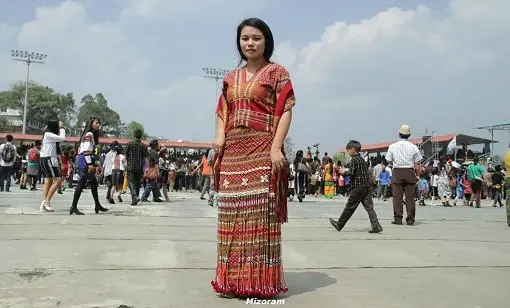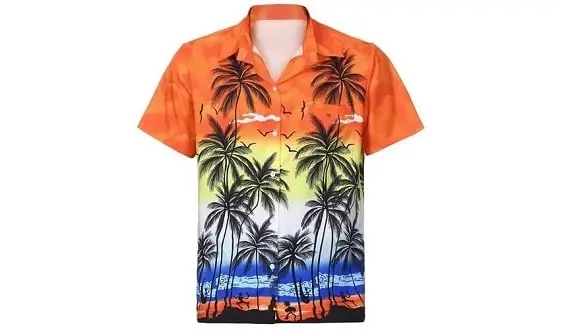One of the seven sisters from the northeastern part of the world is Mizoram. Assam, Tripura and Manipur are its internal neighbours, and Myanmar and Bangladesh are its external neighbours. The traditional attire of Mizo individuals is the same as that of the other northeastern states in the nation. Many people from all around the world are attracted to these vibrant yet straightforward dresses.
Mizoram, a captivating state tucked away in northeastern India, is well-known for both its stunning natural surroundings and its illustrious past. The colourful ethnicity and enduring traditions of the Mizo people are reflected in their traditional clothing. This article highlights the various fashions for both men and women while taking you on an engrossing tour through Mizoram’s traditional attire.
Mizoram Traditional Dress for Female
The traditional clothing of Mizoram for ladies is referred to as “Puan.” The Puan is the epitome of grace, refinement, and fine craftsmanship. The wraparound skirt, blouse, and shawl are the three main components of the women’s traditional attire.
- Kawrechi: The full-sleeved blouse, or “kawrechi,” is typically composed of cotton or silk. It is decorated with vivid colours and vintage designs to reflect the Mizo community’s abundant cultural past. The Kawrechi is a remarkable masterpiece because of its beautiful stitching and motifs.
- Puanchei: The Puanchei, or wraparound skirt, is a crucial element of traditional clothing. It appears in a range of hues and patterns and is crafted from handwoven fabric. Mizoram’s talented weavers use vivid threads to create stunning motifs including fauna, flora, and geometric patterns.
- Hmaram: A shawl woven of Mizo handloom, the Hmaram finishes the look. It is wrapped elegantly across the shoulders and worn over the blouse. The magnificent designs and hues of the Hmaram represent the unique characteristics of the numerous tribes of Mizoram.
Tribal Dresses
The traditional clothing for women in the Lusei tribe is a blue skirt made of cotton fabric. The women of this tribe wear this blue skirt with a white jacket and a body-wrapping piece of fabric. Without a headpiece on top, the outfit is lacking. These headgear’s basic components are bass and cane.
Another traditional outfit worn by Mizo tribes’ unmarried girls is called a zakuolaisen. This is a blouse with lovely crimson stripes all over it. The girls don a clothing known as “Puon Pie” once they get married. This outfit is made of woven fabric that resembles a bedspread. Following marriage, this clothing must be worn, and it has considerable cultural significance.
Mizoram Traditional Dress for Male:
In Mizoram, men dress traditionally in “Puanchei-awm.” Although simpler than women’s dress, it nonetheless displays the Mizo individuals’ cultural significance and customary values.
- Kawrchei: Men’s traditional outfit comprises a blouse known as Kawrchei, which is comparable to women’s clothing. The Kawrchei is normally composed of cotton and embellished with straightforward yet fashionable patterns. It provides comfort and enables mobility.
- Lungi: The term “lungi” refers to the traditional male undergarment. It is a handwoven skirt that wraps around the body. Just below the knees, the Lungi is fastened at the waist. It comes in a variety of hues and designs, bringing a splash of colour and brightness to the entire outfit.
- Puandum: Men wear the puandum, a distinctive shawl that represents their cultural identity. It is slung across the shoulders and gives the conventional outfit a special charm. The Puandum features timeless designs and vibrant colour schemes.
Tribal Dresses for Men
Only cotton fabric is used to make the clothing worn by men who are members of the Lusei tribe. They grow this cotton within their area. Mizoram’s traditional men tend to dress in white, while striped blue clothing is also seen occasionally. Ordinary Lusei as well as the community’s leader wear similar attire, with few distinctions.
The only time these costumes vary is at festivals. The fighter’s outfit in Lusei society consists of a fabric that can be worn around the waist, a knapsack, a bear or tiger pelt slung over one shoulder, plus a gun or other weapon slung over the other shoulder. The Hmars tribes are Mizoram’s top weavers when it comes to displaying a variety of patterns. Hmaram is a handmade fabric that is well-known among children and is also referred to as “kawkpui zikzial.”
The Paiteis outfits are extremely eye-catching and enticing. Thangou Puon has been chosen as the preferred option and favoured outfit by the Paiteis communities. The only person who can legitimately claim ownership of the garment is a warrior that has decisively defeated a sizable number of opponents in a tribal conflict or another conflict of a like nature. Another Mizo tribe whose attire is similar to other tribes is Riang.
Conclusion
The Mizo community’s abundant cultural heritage and artistic prowess are reflected in the traditional dress of Mizoram, which is worn by both men and women. Their ancestors’ experiences and the deeply ingrained customs they cherish are told through elaborate patterns, vivid colours, and ancient motifs woven into the fabric. The Mizo individual’s traditional clothing not only acts as an expression of pride and appreciation for them, but it also symbolizes a feeling of identity.

Santosh Kumar is an editor at unfoldstuffs.com and a professional content writer. With years of experience he is passionate for creating engaging, informative and impactful topics.










